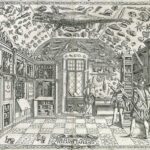What better amusement in this Season of Wonders might there be than to create a “Cabinet of Wonders?”
No ordinary piece of furniture, but a repository of the unusual and the remarkable, Cabinets of Wonder have contained objects of ethnographic or archeological interest, religious or historical relics, and medical oddities.
Beginning as whole rooms, or Wunder Kammers, first read about them here: in this Wall St. Journal article and learn that they “were designed to facilitate an encyclopedic enterprise, the aim of which was the collection and preservation of the whole of knowledge.”
The English plantsman, John Tradescant, had a room of cabinets filled with such things. At Oxford University’s Ashmolean Museum read about his collection, including a dodo bird, a walrus jaw, numerous armadillos, a mermaid’s hand, a dragon’s egg, and two feathers of a phoenix’s tail. In the 1630’s, this collection at was displayed at “Tradescant’s Ark,” their Lambeth residence. This was the earliest major English Cabinet of Curiosity, open to the public for a small entrance fee, and an early precursor of the “museum.”
The earliest pictorial record of a natural history cabinet is at Wikipedia. Search Ferrante Imperato, a 16th C. Neapolitan apothecary whose cabinet is crowned by a stuffed crocodile suspended from its vaulted ceiling. Stuffed crocodiles aside, who among us has not dropped to their knees in a meadow or on a mountain, to cup a dead butterfly, a bird’s egg intact, the husk of a creature long dead? The picture is above and the article about Imperato is here: http://en.wikipedia.org/wiki/Ferrante_Imperato.
Want to know more? Check out www.cabinetmagazine.org/issues/20/olalquiaga.php and www.cabinet-of-wonders.blogspot.com/2008/01/wunderkammern-vs-cabinets-of-curiosity.html.
And so, the Virtual Gardener wonders – might we create a Cabinet of Wonders? The display case near the Haggerty Education Center’s Lobby would be a fine location. The Virtual Gardener herself has something to contribute to this effort: A seed from the Bodhi Tree, Ficus religiousa, which has been split and its interior carved with a Buddha.
Do you have something rare and unusual from your travels abroad or your backyard sojourns? A strange stone, the feather of an unknown bird, richly carved sea glass, bone or wood? Might you be willing to loan it to us for this display?
